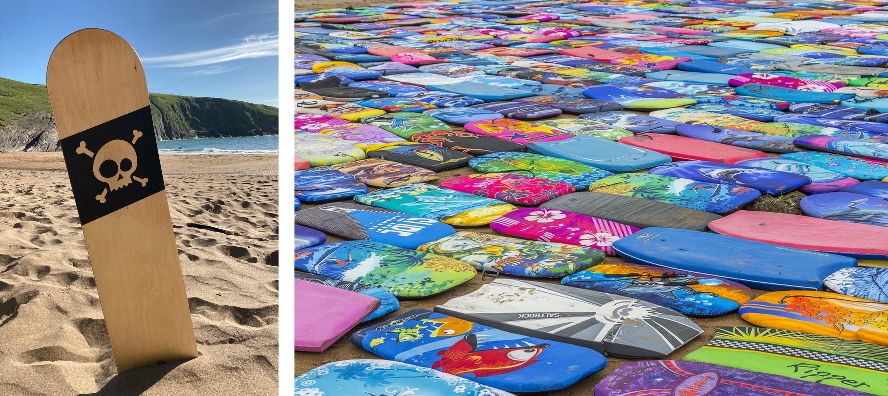How to Paint a Bodyboard - Customised, Eco Friendly Bellyboard alternative
Posted by Celtic Sustainables on 5th Jul 2021
We are so pleased that wooden bodyboards are making a comeback. You too may have read the shocking reports of 14,500 to 17,000 polystyrene bodyboards being lost, abandoned or washing up on UK beaches each year and the disasterous consequences for our marine wildlife.
Our Ian is always one for riding the wave of eco trends, so it was no surprise to us that he had also gone one step further and customised a wooden bellyboard by painting bespoke logo. In this blog post he tells us how to paint your own eco friendly bellyboard. Over to you Ian ...

(left: Ian's finished custom wooden bellyboard, right: a haul of abandoned environmentally-toxic polystyrene bodyboards source #surfwoodforgood @dickpearce)
Roll the clock back to the late 70’s and visit Dunravens Bay in South Wales during the School summer holidays and you may find me, my brother and my Dad up to our bare chests in frothy white water, jumping into waves with little more than a plywood plank. I can still remember the exhilaration of ‘surfing’ my first belly board a handmade board made by my dad. He had even decorated it with a little skull and crossbones painted in the bottom right hand corner.
Move forward 40+ years and I’m still enjoying the thrill of the waves and I occasionally get out on my longboard. However, I have been considering an alternative method of ’wave riding’. I’m not giving up the surfboard. But there are days when it would be nice just to grab a bodyboard and have some fun in the messy waves with the rest of my family.
Eco bodyboard
Searching online for an eco-friendly bodyboard alternative, I found a company who manufacture a sustainable wooden alternative called a bellyboard – wow, I’m immediately transported back to my childhood. It seems that these little wooden boards are experiencing a bit of a ‘come-back’ and there’s even an annual bellyboarding championship held in Cornwall.
Dick Pearce and Friends, the bellyboard manufacturer in cornwall offer several great designs but I couldn’t help noticing that they offered a ‘Naked’ board. An option without a paint or varnish (see image 1 below). A great opportunity I thought to join the current trend within bellyboarding circles and create my own unique custom board. A quick phonecall and they even agreed to send me a board without the main screen printed graphic so I could add my own design.
The order was sent, and I set about designing the graphic. As an homage to my dad’s handywork, I decided to go for a skull and cross bones design.
How to paint a bodyboard or bellyboard

I was going to need a hardwearing finish for the design, so I opted for Graphenstone’s Grafclean paint for the pirate graphic, a paint that contains a graphene, a particularly tough carbon based material which give the paint a super strong finish when dry. I chose Osmo’s Polyx Oil (satin) for the overall protective finish for the wooden bellyboard and, although it isn’t specifically designed for exterior use, I figured the oil and wax mix would be a great choice for my environmentally friendly surfboard and If I needed to top up the finish I could do so easily. The Osmo Polyx Oil doesn’t need to be sanded before reapplication, just a quick wipe over to remove any sand, dirt and salt.
I made a stencil for the actual pirate graphic and decided on a textured finish rather than a brushed finish, so i dabbed on the Graphenstone Grafclean paint through the stencil with a brush. Just 1 coat of the Ebony coloured grafclean was enough to give a solid colour (image 2 above). Once the black paint was dry, 3 thin coats of the Osmo Polyx Oil were applied over the board as a protective coat (image 3 above). After 24 hours I lightly sanded the finish with some 1200 grit wet and dry sand paper to get a nice polished finish (image 4 above) and a couple of days later I was in the water trying it out (image 5 above).
The childhood memories all came flooding back as I was being pushed along by the waves, putting a huge smile of my face. it’s also great to know that if I ever break or lose my board, it’s not going to add to the huge plastic waste problem that our planet is currently experiencing.
Give it a go and make a difference.
If you find yourself in Cornwall and are interested in trying out a bellyboard, The manufacturer of my board, ‘Dick Pearce and Friends’ are now running a rental scheme from several surf outlets. The scheme has been organised to try and reduce the hundreds of cheap body boards currently being discarded on beaches and ending up in the sea and around the coast as plastic waste . For more information check out the Surf Wood for Good blog.
Tester tins
You can purchase tester tins of both the Osmo’s Polyx Oil and Graphenstone Grafclean paint. These small tins are perfect for an eco project of this size.


